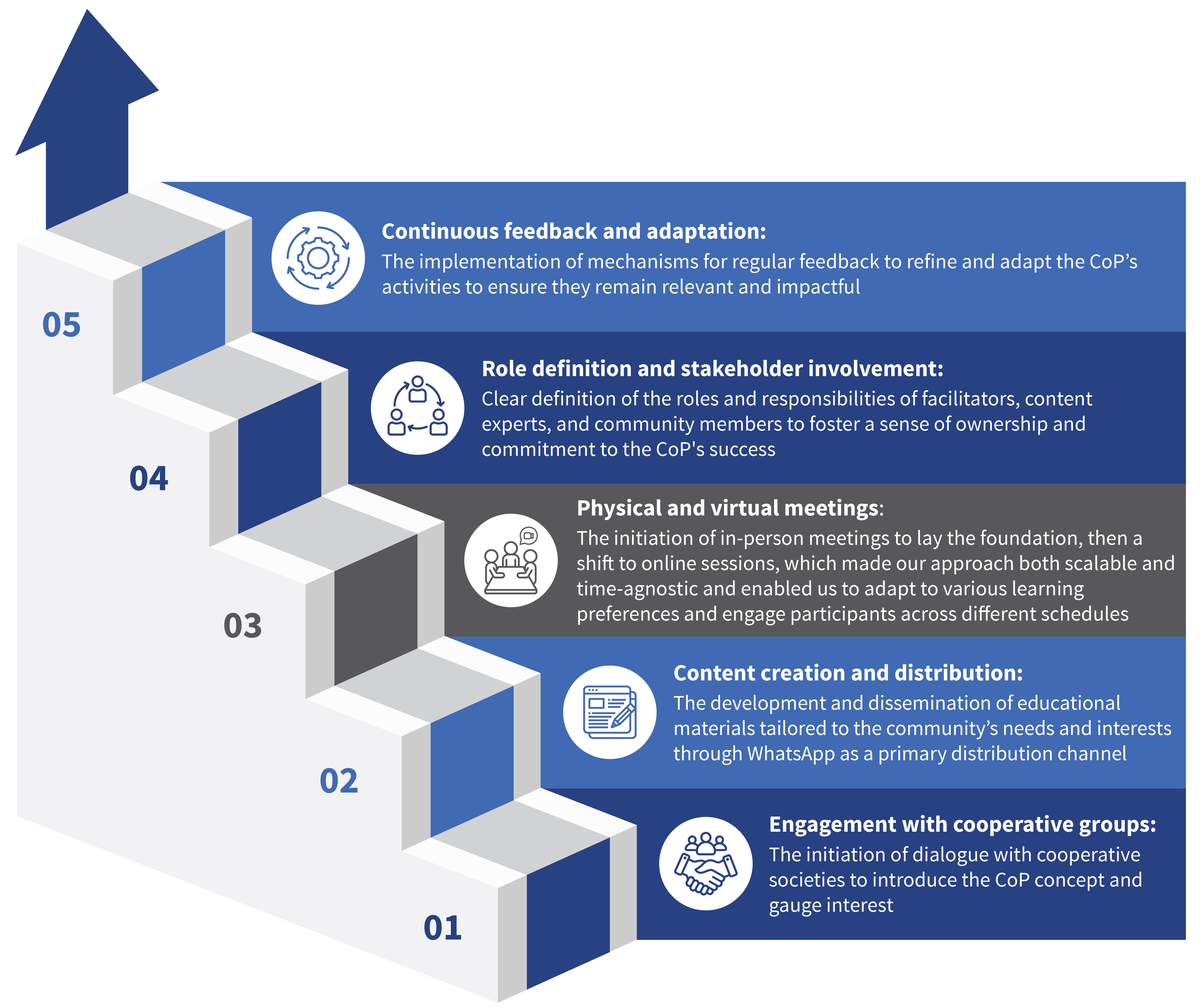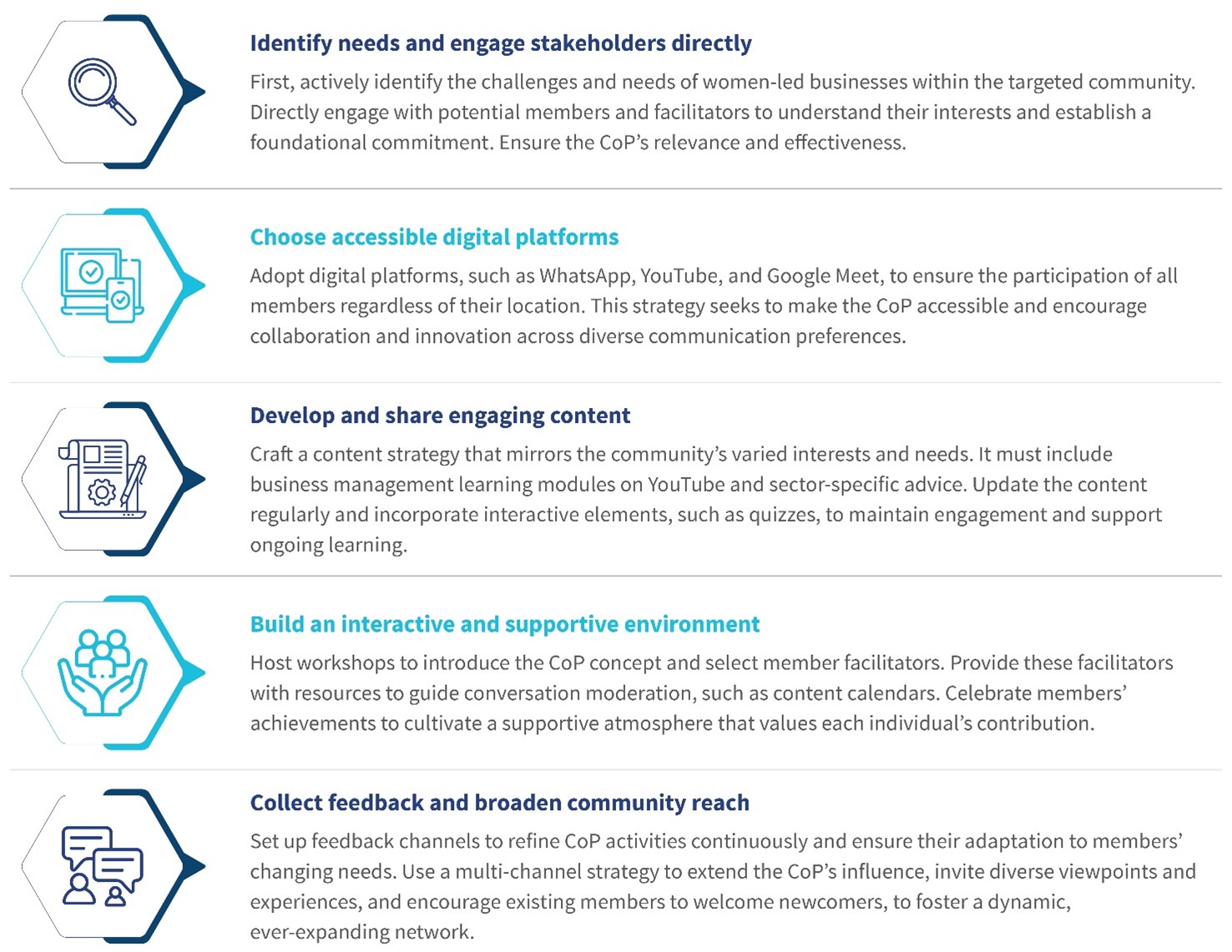Community of Practice: Creation of local knowledge networks through innovative tech solutions to support women-led businesses’ expansion
by Disha Bhavnani and Rutuja Jadhav
Mar 7, 2024
7 min
Today, more than 15.7 million WLBs in India contribute significantly to the economy. Despite their impact, they face challenges due to their lack of knowledge of business aspects. Community of Practice (CoP) emerges as a lifeline in this context. This blog explores CoPs, highlights MSC’s work to build and sustain COPs, and provides a way forward.
Background
“I have just started my business and do not know what credit is and how I can use it to benefit my business. I am too afraid to ask anyone and do not know where to go,” rues Sita, a budding women entrepreneur from Gujarat. Her situation highlights the critical need for stakeholders to encourage and integrate peer-based learning and growth into the ambitions of women-led businesses (WLBs) like hers.
For any business, knowledge is as essential as financial capital. It fosters shared learning experiences, particularly among WLBs, and serves as a catalyst in their growth. Today, more than 15.7 million WLBs in India contribute significantly to the economy. They employ 27 million+ people. Despite their impact, they grapple with many challenges rooted primarily in the lack of knowledge of business aspects, such as bookkeeping and supply chain management. The unorganized sector also struggles with information asymmetry.
The potential of Communities of Practice (CoPs) becomes evident in such a dynamic landscape. They serve as a valuable source of shared knowledge to foster empowerment and encourage collective wisdom within communities.
A CoP is a collaborative network where individuals bond over a shared interest or field and engage in collective learning and expertise development. WLBs exchange knowledge, innovate, and solve problems through regular interaction. They also enhance their professional practices and personal growth.
Figure 1: Steps involved in the set up of our CoP in Gujarat
CoPs are more than just groups of people with similar interests. They are dynamic gatherings where people learn, share, and grow collectively—enabled by simple technology. A CoP is built on a shared domain of interest. A belief that learning is a social activity rooted in WLBs’ interactions and experiences drives community building. It fosters identity and focus alongside a committed community that learns and shares knowledge together. These elements create a rich environment for WLBs to develop expertise and solve problems collectively.
CoPs emerged as a lifeline in this context. They provide a supportive network to share strategies, solutions, and successes. MSC recognized that these CoPs were bound by the pursuit to deepen their expertise and solve complex challenges collaboratively, unlike informal networks or work teams. They transcend institutional and geographical boundaries.
How we build a CoP
We started our CoP in Gujarat with the SEWA Federation’s WLBs to address the awareness-related challenges around entrepreneurship. A recognition that digital platforms could demolish barriers, connect remote areas, and foster a spirit of collaboration and innovation drove this mission. We could create a scalable and accessible model for collective growth and learning through technology. Our choice to use WhatsApp was strategic. Its universal appeal, high uptake, usage, and ease of use made it an ideal platform. We shared educational content through WhatsApp, facilitated discussions, and built a strong sense of community. This approach allowed us to reach WLBs where they were most comfortable, and we made learning and engagement natural, effective, and self-paced.
A CoP’s establishment in any geography follows a meticulous process. It begins with the identification of stakeholders and the assessment of local needs. In Gujarat, it involved five steps that are illustrated in the infographic below:
How we sustained the process
In our latest journey with CoPs on WhatsApp, we crafted a tailored, bottom-up approach that aligns with the community WLBs’ specific interests and needs. We have listed strategies that enabled us to keep these groups active, engaged, and continuously learning below:
- Moderation and guidance: Facilitators in our CoPs, who were also WLBs, were crucial to uphold the focus and respectfulness of discussions. We conducted on-ground workshops to enhance their effectiveness and set the context. We identified WLBs who could lead these conversations during these workshops. We created content calendars for the facilitators to simplify the moderation process. This strategy ensured our interactions stayed meaningful, engaging, and aligned with our community’s inclusive values.
- Regular content updates: We prioritized the creation of learning modules on YouTube as we recognized varied interests and needs within our community. We ensured the content was relevant and timely. Our offerings included a broad spectrum of materials—from instructional videos and hands-on advice to best practices across various areas, such as credit management, insurance, social media marketing, and digital payment processes. We also developed tailored content on topics to cater to our community’s unique sectors, such as animal husbandry for dairy cooperatives and stitching techniques for handicraft cooperatives. This strategic approach to content creation ensured our learning modules were informative and directly applicable to the varied needs of our community WLBs.
- Interactive activities: We launched interactive activities that merged learning with fun as part of our strategy to deepen member engagement and knowledge. We introduced creative challenges to spark innovation, quizzes to solidify knowledge, and gamification methods, such as points and badges, to create a competitive yet enjoyable learning environment. Calls to action kept the WLBs engaged, led them to the next learning experience, and ensured ongoing participation. We expanded viewpoints through discussions on various topics and made each interaction an insightful moment. This approach made learning enjoyable, promoted critical thinking and collaborative learning, and fostered a dynamic educational community environment.
- Bridging the digital skills gap: A lack of digital skills among WLBs was a significant and often overlooked barrier that prevented full digital engagement. Our workshops thus sought to improve digital skills. These covered everything from basic smartphone usage to advanced online safety practices and empowered WLBs to navigate digital spaces more confidently.
- Member spotlights: The recognition and celebration of individual achievements and contributions were central to our community-building strategy. We highlighted our WLBs’ successes, acknowledged their efforts, and reinforced their value within the community, which enhanced the collective sense of belonging and mutual appreciation. We could also see a positive uptake in the group’s interactions after the recognition activity.
- Feedback loops: The establishment of effective feedback channels was integral to our adaptive strategy. It allowed the WLBs to voice their opinions and suggestions about the CoP’s activities. We went on the field and got in-person feedback from different sets of women to implement it in our CoP activities. This invaluable input enabled us to refine our approach continually and ensure the community’s evolution in alignment with the WLBs’ shifting needs and interests.
- Expanding our reach: We embraced a multichannel strategy and extended our engagement to include WhatsApp, YouTube, and Google Meet, among other technologies, to connect our CoPs effectively. This comprehensive approach ensured quality interactions across various platforms that would cater to the WLBs’ diverse preferences. It facilitated active participation and encouraged them to invite others into our community.
Figure 2: Standard guidelines to form a CoP
The journey from here
As the initiative looks to the future, its experiences with SEWA in Gujarat offer a blueprint to expand CoPs. This experience promises to revolutionize how women entrepreneurs connect, learn, and grow together. Yet, a sustainable structure requires key stakeholders’ engagement and clearly defined roles for facilitators, WLBs, and experts. Regular interactions, shared goals, and a commitment to mutual growth form the bedrock of a successful CoP.
An examination of CoPs across different sectors and countries reveals diverse applications and outcomes. The transformative power of CoPs to foster knowledge sharing and empowerment is evident in MSC’s multicountry initiatives across Vietnam and Nepal.
Figure 3: Steps involved in the set up of the CoP in Vietnam
Vietnam’s CoP activities had multifaceted outcomes. These ranged from enhanced individual and organizational capacity for work-life balance to the creation of supportive online communities and increased access to vital resources.
In Nepal, MSC’s partnership with Women Act Nepal and other local entities shows a comprehensive three-phase CoP initiative to empower women entrepreneurs across several provinces.
Figure 4: Steps involved in the setup of the CoP in Nepal
We measured our CoPs’ impact through tangible and intangible metrics. Increased member engagement and knowledge exchange and significant business improvements indicated success. We engaged with more than 12,000 rural WLBs across India through WhatsApp groups and more than 20,000 women globally. We ran pilots with more than 10 cooperatives under the SEWA Federation. When the women in these groups were educated about the CoP platforms, they received the instructions well and felt confident enough to share voice notes in the group. These outcomes validated the effectiveness of CoPs and highlighted their potential as catalysts for change and development.
The way forward
The future integration of CoPs into organizational structures, particularly in lower-income sectors, presents an exciting opportunity for widespread learning and empowerment. New digital collaboration tools and methodologies promise to revolutionize how CoPs function and make them more accessible and impactful. As CoPs gain global traction, they will emerge as crucial channels for knowledge sharing and innovation across borders. Their global perspective would enrich the CoP model and ensure its relevance in an increasingly interconnected world.
The cultivation of knowledge through CoPs is more than just shared learning. It builds a supportive network that transcends geographical and cultural boundaries. CoPs offer a platform for empowerment, innovation, and collective growth, especially for women-led businesses that face unique challenges. Our experiences across different regions underscore these communities’ transformative power as they chart a future where knowledge is freely shared and collective wisdom is key to overcoming challenges.
We at MSC seek to strengthen existing CoPs under our partners and identify newer engagement areas to build more collaborative cohorts. Our objective is to weave the fundamentals of CoP as proof of concepts, so WLBs see their value, ingrain these as an inherent part of their structure, and build and nurture these communities.
Written by

Disha Bhavnani
Senior Manager
 by
by  Mar 7, 2024
Mar 7, 2024 7 min
7 min 



Leave comments